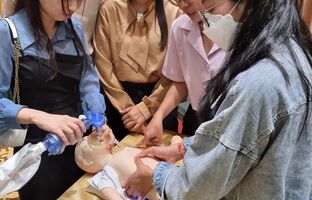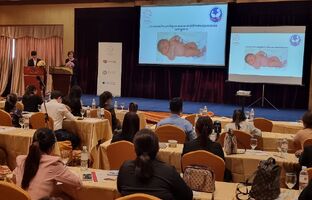The main objectives of the project are to reduce maternal mortality during childbirth, reduce perinatal mortality, and reduce child mortality within the first 5 years of life. I talked about the project and especially the course of the January working trip to Cambodia with Petra Pařízková, a midwife and project coordinator.
What was the composition of your team?
The team composition was diverse. We had obstetricians, neonatologists, anesthesiologists, a diabetologist, a midwife, a pediatric nurse, and paramedics, mainly from the General University Hospital in Prague – VFN and the First Faculty of Medicine, Charles University. We also had representatives of bioengineering and modern IT technologies, as well as interpreters.
How did you start your rich program?
Right at the beginning of the first day of the symposium, the Cambodian national anthem was played, which demonstrated the importance that local doctors and midwives attached to our interdisciplinary educational congress as part of the help supported by the Czech Development Agency. Then there was lecture after lecture. Midwife Mgr. Alžběta Němcová introduced triage for low-risk and high-risk pregnant women in our country, followed by care for low-risk pregnant women and mothers by midwives. MUDr. Zuzana Kokrdová presented novelties in the field of preeclampsia. A lecture by MUDr. Hana Krejčí on diabetes in pregnancy was significantly impressive. The day ended in the late afternoon with presentations on premature delivery, with the audience particularly appreciating video presentations of interesting case studies from our clinical practice. It was nice to meet the director of the National Pediatric Hospital, Nhep Angkeabos, after a year, who highly appreciated our work in creating English-Khmer slides.
What else did you cover in your lectures?
On the second day, we began with an introduction to today’s recommended practices for Caesarean section deliveries (by MUDr. Kateřina Slabá, prof. MUDr. A. Pařízek, CSc.). This was followed by a presentation on extraction methods in obstetrics, such as vacuum extraction and obstetrical forceps. These are life-saving methods that every obstetrician should be able to handle, even though forceps are in decline worldwide. There are still situations where they cannot be avoided in order to save the life of the child or mother. Obstetric forceps were seen for the first time by some midwives and doctors. We then presented the latest developments in life-threatening bleeding during childbirth, from both the obstetrician’s and anesthesiologist’s perspectives.
Did you also have a practical demonstration of your procedures?
Yes, our colleagues from Cambodia prepared a mother who was undergoing a repeated Caesarean section for us to demonstrate our technique. Honestly, operating in a completely unfamiliar environment, when not all healthcare professionals speak English, with instruments that are identical yet different, did not add much calm. However, the spinal anesthesia, brilliantly introduced and performed by MUDr. Jan Bláha, and the Caesarean section performed by Prof. MUDr. A. Pařízek, CSc., with the assistance of MUDr. Zuzana Kokrdová, and with Mgr. Alžběta Němcová securing everything along with the Khmer instrumentation, went smoothly. We received applause, which someone called “applause,” because there were an unusually large number of spectators in the operating room.
What other important information did you focus on in your lecture program?
Everyone who works in the delivery room knows that in cases of acute problems, the anesthesiologist is an absolutely key person. This is known by every obstetrician, neonatologist/pediatrician, and every midwife. When a child is suffocating (technically, experiencing hypoxia) and an emergency cesarean section is necessary, or when a woman is losing consciousness due to unexpected rapid and massive bleeding during delivery (technically, peripartum life-threatening bleeding), everyone immediately calls for the anesthesiologist on duty. The anesthesiologist quickly takes care of ensuring breathing for the much-needed oxygenation of the blood and subsequently the tissues, especially the uterus. They secure intravenous access to administer the necessary fluids, including blood substitutes, while also administering medications that support blood coagulation. Therefore, one whole day of our educational congress was devoted to anesthesia and intensive care medicine. The Cambodians were enthusiastic and requested, beyond the program, to hold a workshop directly in their hospital.
Premature birth and associated complications, such as infections, are often a problem in Cambodian hospitals within neonatology. I assume that you also addressed this issue.
Of course. After the obstetric and anesthesiology sections, neonatology came next. Colleagues from the National Pediatric Maternity Hospital showed great interest in innovations in the care of not only children who were fortunate enough to be born on time but especially those who had the misfortune of complications at the start of their lives, namely premature birth. A lack of oxygen during childbirth can cause a serious catastrophe in a child, namely brain damage. And there are many such cases here. There isn’t even one cardiotocograph in the entire province (11,000 births). Therefore, as the first topic, our neonatologists, led by Dr. Jan Smíšek, presented this issue (technically, hypoxic-ischemic encephalopathy), its diagnosis, and treatment. He pointed out that timely neonatal/pediatric intervention and proper resuscitation can be key means of managing this serious pathology. This was followed by the issue of early and late infections in newborns, especially to prevent the promotion of antibiotic-resistant bacterial strains.
What else is crucial for the healthy development of a newborn?
For example, the stabilization of the newborn is crucial. Professor Richard Plavka demonstrated lung issues immediately after birth during his teaching on this topic, mentioning the importance of late umbilical cord clamping, including basic steps of resuscitation. He described the respiratory support of high-flow nasal cannulas and addressed bronchopulmonary dysplasia, its diagnosis, treatment, and mainly prevention. MSc. Zuzana Tomášková delivered practical lectures, emphasizing the importance of thermoregulation in both premature and immature newborns. Her lecture on the significance and technique of breastfeeding aroused interest not only in the attentive audience. Cambodian neonatologists and pediatric nurses attended in large numbers and had numerous questions. Modern “baby simulators” purchased by the Czech Development Agency were also put into operation for these purposes when our colleagues in Cambodia received detailed information on how to use these modern tools.
One of the Czech Development Agency’s projects in Cambodia is focused on the much-needed field of bioengineering. Have you also addressed this topic?
Yes, the last day of our visit was dedicated precisely to bioengineering, directly at the National Pediatric Hospital. During the conference preparation, there were heated discussions about whether it could be organized on Saturday when it is not customary to work much here. The reality? There was no place to sit during the presentations by Professor Petr Kudrna and engineer Lucie Novotná. An unprecedented number of healthcare workers also came from Kampong Chnang province. It turned out that bioengineering must be an integral part of our development cooperation to enable people to operate often highly specialized equipment, which is provided through the Czech Development Agency at considerable cost. By the way, Petr Kudrna put our gift into operation in practice before the interested parties’ eyes. A device for C-reactive protein (CRP) analysis for inflammation diagnosis.
Did your team’s work trip meet your expectations?
Absolutely. Our mission was fulfilled to 200%. Additionally, before our departure, we learned how our Cambodian patient, for whom we ended her pregnancy by cesarean section, was doing. The mother, as well as her daughter, whom the parents named Emília, are doing very well, so we flew home with a good feeling.










